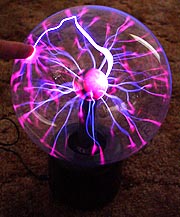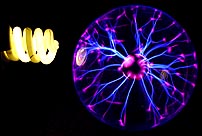

PLASMA LAMPS A simplified explanation with pictures of how these light-effect lamps work
(Click on main site to browse 70 other topics ranging from exotic kaleidoscope designs to the strange world of lucid dreaming.)

Whether you call them nebula spheres, plasma lamps, or lightening balls, these lamps put on one of the most unique displays available. Twenty years ago they cost $1500. Today you can get one in Wal-Mart for as little as $40.
To understand how they work it's necessary to start off by explaining how a capacitor functions.

A capacitor is a device that can store an electrical charge. It's simply two parallel metal plates separated by an insulator. (For the sake of this explanation, the insulator is air.) If you connect a battery to one, for a brief moment current flows into one plate and out of the other, storing a charge on each. Very quickly the storage capacity of the capacitor maxes out and the current stops flowing. If you make a capacitor with very large plates, the current will flow longer before the plates fill up with charge. The important thing is that during the brief time before the plates become fully charged, current flows through the wires to and from the capacitor even though no current is actually passing between the two plates.
Now, if instead of the steady electric current provided by a battery an alternating current from a power supply is used, then the capacitor is constantly being charged in one direction, then the other. With each pulse there is a short period when current is flowing through the wires to and from the capacitor even though, again, no current passes between the plates of the capacitor. If the rate of the current pulses is high enough and the capacitor is large enough so that significant current flows through the wires an electric lamp could be placed in between the power supply and the capacitor and it would light.

If we speed up how fast the current oscillates and increase the voltage from the power supply, the distance between the capacitor's plates can be increased and enough current will still travel through the wires to light the lamp. Eventually, the plates of the capacitor would be so far apart that you could pass your hand between them. Essentially, that's how the power system of a plasma lamp works. One side of the capacitor is the small ball electrode inside lamp's glass sphere and the other is inside the power supply. The insulator between these two electrodes is the gas inside the glass sphere, the glass sphere itself, and the air outside the glass sphere between the sphere and the second electrode inside the power supply.
What we need to do next is understand how a second capacitor taking the place of the lamp can be made to act like the lamp in the circuit above.

Think back to the first diagram of the capacitor and the battery. If instead of just one battery, connect hundreds in series and eventually there'd be enough voltage for a spark would jump across the gap. What's happening is that the electric field between the plates becomes large enough to break down, or ionize, the air between them. (Ionized atoms are simply atoms that have had one of their electrons knocked off.) Ionized air is a conductor and electricity flows through it. While this is happening, some electrons go from being ionized back to being un-ionized. When this happens they give off a flash of light. The color of this light depends on what type of gas is used. Now, if the batteries were replaced with a pulsing power supply, the sparking would be continuous. If the pulse rate, or frequency, was fast enough the sparks would blur together and appear to give off a steady light.
The next step is to enclose the capacitor in a glass sphere filled with gas. If we then reduce the gas pressure in the sphere, the gas becomes more conductive and we can pull the electrodes further apart, making it easier to see the light. (At this point the capacitor is no longer working like a capacitor because current is flowing through it, but I'll still call is one because that's how it started off.) With the right combination of frequency (usually around 10,000 oscillations per second), voltage (around 2,000 volts), low pressure (1/70th of an atmosphere), and distance (3 to 4 inches) the gas between the two electrodes is so conductive that current can flow easily through it. It'll glow with a even soft light. But, this case is one in which nature doesn't like uniformity. Slight variations in gas temperature create warmer zones where the gas's conductivity is higher than the surrounding areas. Since current seeks the path of least resistance, more current will flow through these warmer areas, warming them more, so more current flows through them, and so on. Because more current passes through these streams it glows brighter. These brightly glowing streams are the streams that make up the light show in a plasma sphere. The central metal electrode inside a plasma ball is one side of the capacitor we've just finished converting into a light bulb. The other side is the inside the power supply as mentioned before. By selecting the right mixture of gases to fill the sphere, the streamers take on interesting colors because each gas glows with a characteristic color. The gases used in plasma spheres are usually argon, neon and nitrogen, which produce blue, red and white colors.

All that's left to do to make the plasma sphere look more like the ones in stores is to shorten the lengths of the wires between the components and draw the sphere a little larger. Doing this gives the following (admittedly artistically-challenged) diagram.

The bottom plate of the capacitor is now buried inside the plasma sphere's base.
As the current in a steamer flows through the gas, it heats it. Since warm gas rises, the glowing streamer rises with it. That's why glowing steamers are always moving upward in plasma spheres.
An interesting question to ask is: Why do thicker, brighter streams form when a finger touches the outside of the glass sphere?

The mechanism by which an electric field can connect two sides of a circuit across the plates of a capacitor without actually conducting current is called "capacitive coupling." It is affected by anything that changes the ability of the capacitor to hold a charge, such as changing the material between them. In the case of a finger, you are introducing something that increases the capacitive coupling in one small location. That means that around the area you touched there is a stronger electric field, which means more current can pass through any streamers that are close to that area. More current means that they glow brighter and tend to be more stable.
The reason you don't feel anything when you touch the sphere is that no current passes through the glass shell and into your finger. Current isn't flowing from the central electrode out through the glass sphere. Rather, it's jumping back and forth between the central electrode and the inside of the glass sphere so fast you can't see the individual pulses. The process is like a rubber ball bouncing back and forth between two walls so fast that it looks like a solid stream.
One trick with plasma spheres is to hold a fluorescent light near one.

The pulsating field around the glass sphere is strong enough to excite the mercury gas inside the fluorescent bulb, which in turn excites the fluorescent coating on the inside of the glass spiral and makes it glow.
If you'd like a more detailed and scientifically more correct explanation of how plasma spheres work, please visit Sam Barrow's excellent site at: http://www.powerlabs.org.
Please click HERE to visit my main site and browse 90 other pages covering everything from metal detecting to rocket engines.